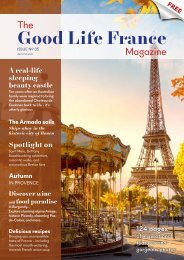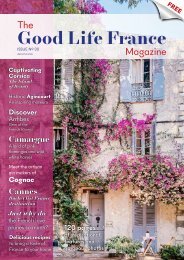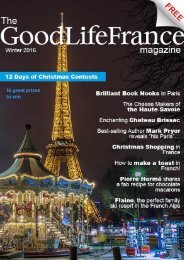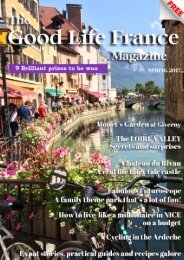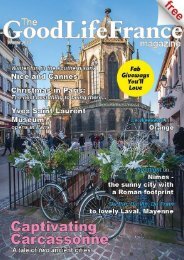Spring 2024
Brimming with fascinating and fabulous features plus fantastic photos, inspiring, informative and entertaining guides, scrumptious recipes from top chefs, history, culture and much, much more. Discover the gorgeous Gulf of St-Tropez, the luminous Opal Coast in the north, pickled-in-the-past Sarlat, Beaujolais, medieval Mirepoix, The Lot, lovely Bergerac, the Oise Valley, the Loire Valley, Champagne, Brittany, Paris & more.... bringing France to you - wherever you are.
Brimming with fascinating and fabulous features plus fantastic photos, inspiring, informative and entertaining guides, scrumptious recipes from top chefs, history, culture and much, much more. Discover the gorgeous Gulf of St-Tropez, the luminous Opal Coast in the north, pickled-in-the-past Sarlat, Beaujolais, medieval Mirepoix, The Lot, lovely Bergerac, the Oise Valley, the Loire Valley, Champagne, Brittany, Paris & more.... bringing France to you - wherever you are.
Create successful ePaper yourself
Turn your PDF publications into a flip-book with our unique Google optimized e-Paper software.
Paris’ legendary<br />
zinc rooftops<br />
Paris’ legendary zinc<br />
rooftops<br />
Have you ever looked at a photo of Paris and<br />
wondered why so many of the rooftops look so<br />
good despite the age of the buildings? It’s all<br />
down to zinc, a humble metal that was chosen<br />
as the roof topping of the ‘modern’ buildings<br />
of 19 th century Paris says Sue Aran.<br />
Much that we love and hold dear about the<br />
City of Light today, we owe to the singular<br />
brilliance of Georges Eugène “Baron”<br />
Haussmann. In 1853, when he began the<br />
renovation of Paris at the command of<br />
Emperor Napoleon III, he was unaware of the<br />
enormous cultural impact his reconfiguration<br />
of the city would have. As a former architect, I<br />
find his vision inspiring and extraordinary. Not<br />
only was he prescient about humanizing the<br />
scale of the city, but he also knew instinctively<br />
that in a grand, large-scale design, rhythm<br />
and harmony of materials were essential.<br />
The beautiful, iconic zinc rooftops of Paris,<br />
which practically all Haussmann buildings are<br />
covered by — and the workers who create<br />
them — were even considered for UNESCO’s<br />
list of French Intangible Cultural Heritage.<br />
Paris’s zinc roofs are thanks to the work of<br />
cleric Jean-Jacques Dony (1759-1819) of<br />
Liège, a part of France at that time though<br />
now it is part of Belgium. Dony was fascinated<br />
by chemistry and by his early 20s, he had<br />
his own laboratory. He spent 25 years<br />
researching the smelting of zinc which is<br />
present in the earth, air and water. It is nontoxic,<br />
a trace element that is indispensable<br />
for all living organisms, a fundamental part<br />
of the metabolic processes of plants, animals<br />
and humans. In the human body, over 300<br />
enzymes require zinc for proper functioning.<br />
Although zinc compounds had been used<br />
for at least 2,500 years in the production<br />
of brass, zinc wasn’t recognized as a<br />
distinct element until 1668, when a Flemish<br />
metallurgist, P. Moras de Respour, pioneered<br />
the extraction of metallic zinc from zinc oxide.<br />
As far as Europe was concerned however,<br />
Paris © Shayna Stillman<br />
View from the Arc de Triomphe © Grace Marshall<br />
zinc was discovered by the German chemist<br />
Andreas Marggraf in 1746, who was the first to<br />
distinguish it as a new metal.<br />
While chemists tried to handle zinc (formerly<br />
known as Indian Tin) it was Dony who<br />
discovered and patented a procedure for<br />
processing and refining sheet zinc, today<br />
50 Romain | The Gandré, Good Life Instagram: France@ rom_buff)<br />
The Good Life France | 51





